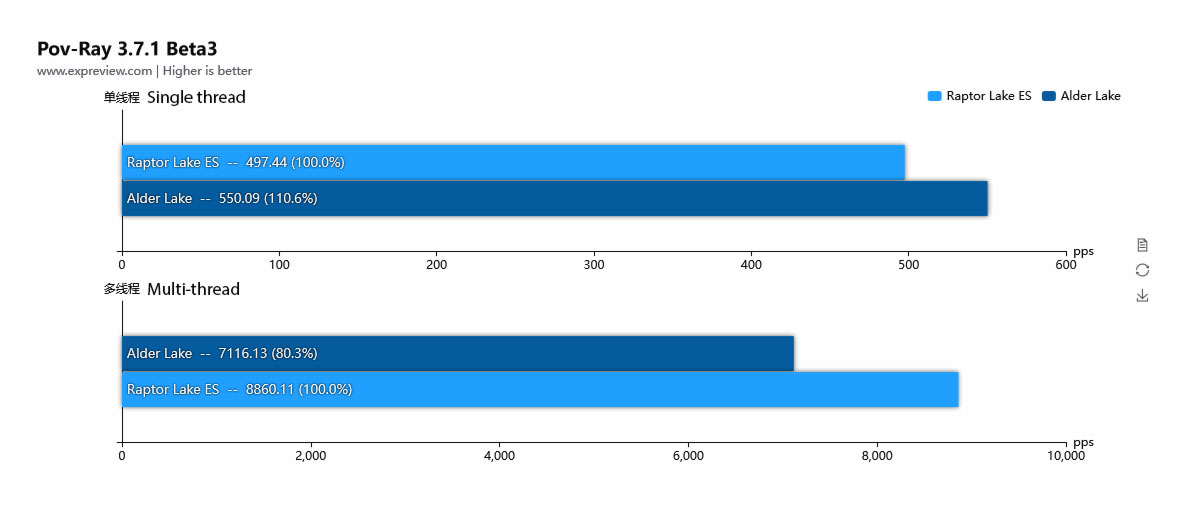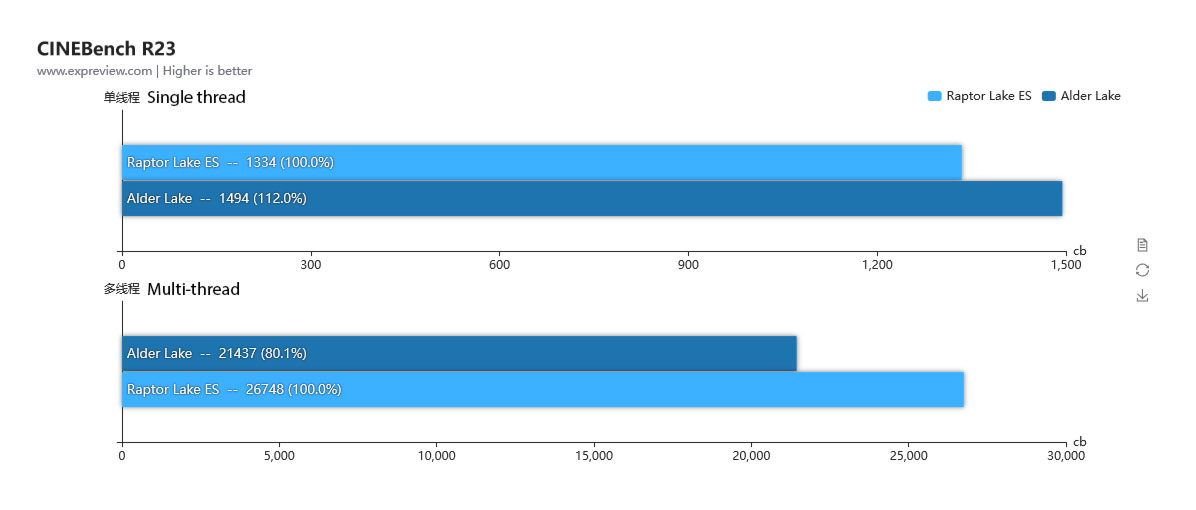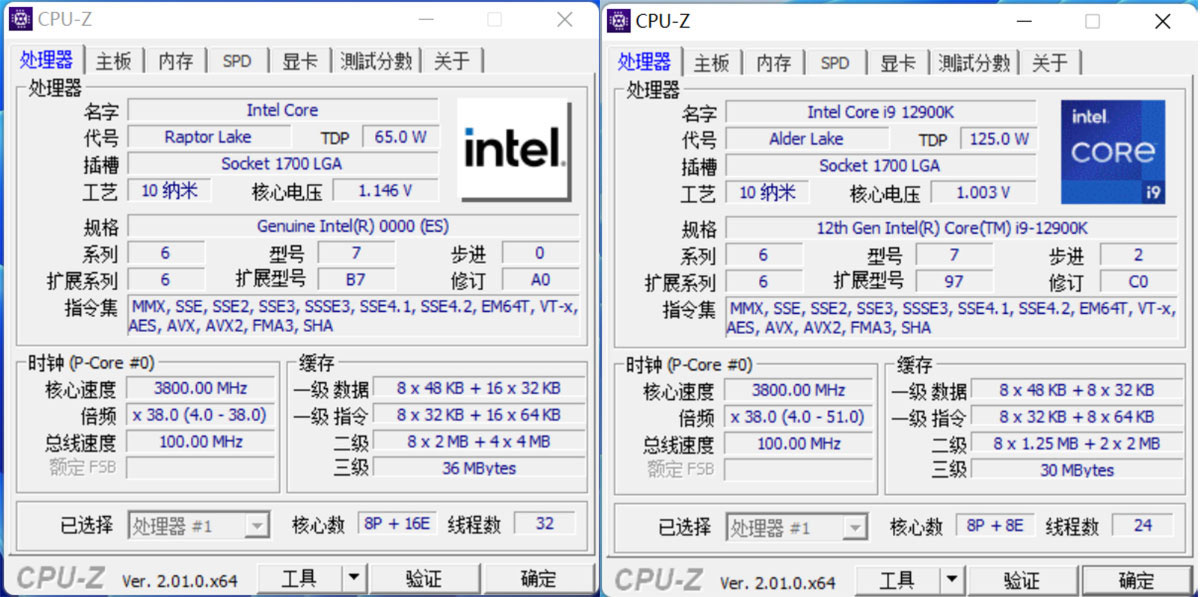Alleged Intel Raptor Lake Sample 20% Faster Than Alder Lake in New Benchmarks
Chinese site pits a 'Core i9-13900' against an i9-12900K in apps and games.
A Chinese tech site has managed to get its hands on an Intel Engineering Sample, which it alleges matches the key specifications of the upcoming Intel Raptor Lake Core i9-13900. However, this particular engineering sample (ES) is a bit of a turtle concerning clock speeds. Thus, to get some meaningful data out of this hardware, EXP Review compared the ES against an Intel Alder Lake Core i9-12900K at iso-frequencies – including setting a very low base clock of just 1.4 GHz. In its artificially stunted tests, it is interesting to learn that the Raptor Lake (RPL) chip is about 20% faster than Alder Lake (ADL) across many multi-threaded tests. This isn't the first time Raptor Lake has been rumored to be roughly 20% faster than the previous gen.
Before going on to look over some benchmark scores, please check out the CPU-Z comparisons between the EXP Review acquired engineering sample (left) and the known quantity, the Core i9-12900K (right). The critical advances for Raptor Lake seen in this comparison are a 25% increase in thread count and worthwhile additions to L2 and L3 cache quantities. EXP Review thinks the engineering sample is the Core i9-13900, as the processor is rumored to have 8 performance cores and 16 efficiency cores like this one. That is double the number of efficiency cores compared to its Alder Lake predecessor. Another advance is expected with a move from Golden Cove to Raptor Cove performance cores.
EXP Review's results are pretty eye-opening, even given the artificial situation and setup necessary for a 'fair' comparison. The tester notes that even at iso-frequencies, there are several drawbacks for the Raptor Lake-powered system. First, this ES is a very early sample with stepping of 0 and revision of A0. Moreover, the ES is planted in a current-gen Z690 motherboard with no explicit support. It would therefore be understandable for the upcoming Intel chip to be a relatively poor performer.
EXP Review completed a wide range of tests with the suspected Intel Core i9-13900 against the Core i9-12900K. The CPUs were swapped in and out of a Z690 motherboard with G.Skill DDR5-5200 16GBx2 memory and an Nvidia GeForce RTX 3090 Founders Edition graphics card. As mentioned in the intro, the Raptor Lake-ES romped home with convincing wins of about 20% on average in multi-threaded non-gaming tests. In these tests, it pulled ahead pretty convincingly in single-threaded tests too. Commonly used benchmarks and apps used to assess CPU performance were rolled out here, including Sandra 2021, 7-Zip, X265, POV-Ray, Blender and Cinebench. Look at some of the sample charts we screen-grabbed and you can see the convincing lead of the suspected Intel Core i9-13900.


Gaming was a different story, with nothing better than a 9% lead enjoyed by the Raptor Lake-based system. Most of the time, the Raptor Lake advantage was just 2 or 3% - within the margin of error. The extra threads offered by the Raptor Lake-ES chip and the boosted caches aren't as warmly welcomed by games as in productivity apps and scientific benchmarks.
Raptor Lake is rumored to feature even faster clocks than what's possible with the Alder Lake generation. In addition, new advanced overclocking modes and other refinements could allow Intel to crow about the first 6 GHz consumer CPU. Thus there is a lot to look forward to with the advent of Raptor Lake CPUs and 700 Series chipsets, expected to arrive in Q4 this year. Those chips will face off with AMD's Ryzen 7000 when it arrives in the Fall.
Get Tom's Hardware's best news and in-depth reviews, straight to your inbox.

Mark Tyson is a news editor at Tom's Hardware. He enjoys covering the full breadth of PC tech; from business and semiconductor design to products approaching the edge of reason.
-
-Fran- Well, as mentioned in the other previous leaks of the ES tests, just keep in mind these do not use final clocks and are, sometimes, full of bugs and need final microcode and stuff.Reply
Reading a bit between the lines though... Doesn't seem like Raptor Lake has major IPC improvements over Alder Lake, but neither clock speeds, so I have a feeling their overall performance increase is not going to be big. Like under 10% most of the time for low threaded works and about 20% in MT workloads, ideally more since the small E cores were improved.
Time will tell.
Regards. -
KyaraM I'm a bit confused by the conclusion. It looks to me as if Raptor Lake is slower than Alder Lake in single-threaded workloads, why does the article talk about a lead? What did I miss?Reply -
spongiemaster Reply
What are the odds that adding a bunch of cache and increasing clock speeds is going to result in slower single-threaded performance?KyaraM said:I'm a bit confused by the conclusion. It looks to me as if Raptor Lake is slower than Alder Lake in single-threaded workloads, why does the article talk about a lead? What did I miss? -
LuxZg From what I've read, Raptor could just as well suffer slight clock regression, so improved clocks aren't certain at all.Reply
And some workloads don't improve with cache.
Thing is, article says one thing, pictures say something else entirely. AND that's at same clocks (underclocked Alder Lake). Both games and both single threaded pictures show lower results. And 20% MT is purely from more cores. 24 thread Alder Lake + 33.33% = 32 thread Raptor Lake. So that single threaded disadvantage even works against it in MT, otherwise we would see 25-30% better MT scores
Ok, we could talk till tomorrow defending each side. One could say they will have barely any ST advantage over AL, and ~25% MT purely due to extra cores, and little or no clock advantage. Basically a typical tick-tock strategy, where they will (finally) lower power requirements and get back in line. Other side could claim that this is all early sample, no microcode, wrong MBO/chipset, that they will get to 6GHz, with +10% ST, and +40% MT, and so on.
But this test does not look good for Raptor Lake at all, despite what the article text says. And looks equally bad for author and website publishing such texts without clearly saying it's all baseless guessing at it's best. -
TerryLaze Reply
That would work if all threads had the same performance but e-cores and p-cores don't have the same performance, even if they would run at the same clocks which they don't, and then there is HTT on top of that.LuxZg said:And 20% MT is purely from more cores. 24 thread Alder Lake + 33.33% = 32 thread Raptor Lake. So that single threaded disadvantage even works against it in MT, otherwise we would see 25-30% better MT scores -
spongiemaster Reply
Not sure what rumor sites you frequent, but I have not seen any rumor that Raptor Lake would have lower clock speeds than Alder Lake. The most recent rumors from yesterday claim that it could reach 6GHz with special editions CPU's.LuxZg said:From what I've read, Raptor could just as well suffer slight clock regression, so improved clocks aren't certain at all.
And some workloads don't improve with cache.
Thing is, article says one thing, pictures say something else entirely. AND that's at same clocks (underclocked Alder Lake). Both games and both single threaded pictures show lower results. And 20% MT is purely from more cores. 24 thread Alder Lake + 33.33% = 32 thread Raptor Lake. So that single threaded disadvantage even works against it in MT, otherwise we would see 25-30% better MT scores
Ok, we could talk till tomorrow defending each side. One could say they will have barely any ST advantage over AL, and ~25% MT purely due to extra cores, and little or no clock advantage. Basically a typical tick-tock strategy, where they will (finally) lower power requirements and get back in line. Other side could claim that this is all early sample, no microcode, wrong MBO/chipset, that they will get to 6GHz, with +10% ST, and +40% MT, and so on.
But this test does not look good for Raptor Lake at all, despite what the article text says. And looks equally bad for author and website publishing such texts without clearly saying it's all baseless guessing at it's best.
Intel XTU gets Raptor Lake update with “Efficient Thermal Velocity Boost” & per-core/package OC TVB support
From the Raptor Lake performance leak:
"In this case the P-cores are running at 1.4 GHz to 3.8 GHz range, while one cluster of E-Cores runs at 1.0 GHz and the other at 2.0 GHz. There is therefore some inconsistency in frequencies, as noted by Wccftech. "
So, there were issues normalizing the clock speeds. In actual use, neither eCore cluster is going to run at only 1GHz. -
PCWarrior The test is in POV Ray 3.7.1. In POV Ray the 12900K normally scores 10410 points while the 12700K scores 9013. So with 4 extra e cores as well as slightly higher clock speed the increase is 1397points. So, given the small differences in clock speeds between the 12700K and the 12900K, the contribution of 4 e-cores alone in 12900K is around 1005 points and the contribution of 8 p-cores is around 8400. Now if you have 16 E-cores you would expect their contribution to be 4020points. And if you have 8 P-cores with 10% performance regression their contribution would be 7560points(=0.9x8400). Thus, you would expect a total of 11580 points i.e. an 11.2% increase compared to the score of a retail 12900K. But here instead we get 20% higher than retail 12900K which would mean a score of 12492. That means that the MT performance of the e-cores in Raptor lake (in POV-RAY) improved by 22.7% (from 4020points contribution to 4932points). That's probably due to the larger cache.Reply
It has to be said here that POV Ray is a test where in Alderlake the percentage contribution of the E-cores to the overall score is rather small compared to their contribution in other synthetic MT tests (e.g. Cinebench). So there was plenty of room for improvement which we see here. Now if we also account for the expectation that that the P-cores of a retail 13900K should see at least a 10% performance improvement (instead of a 10% regression) compared to a retail 12900K, the contribution of the P-cores should be at least 9240 points. Thus, a total 14172 points i.e. the 13900K should score at least 36.1% higher. If we see a 15% performance increase in the P-cores then we are looking at an increase of over 40%. With clock speed increases in the e-cores we exceed that increase even further.


